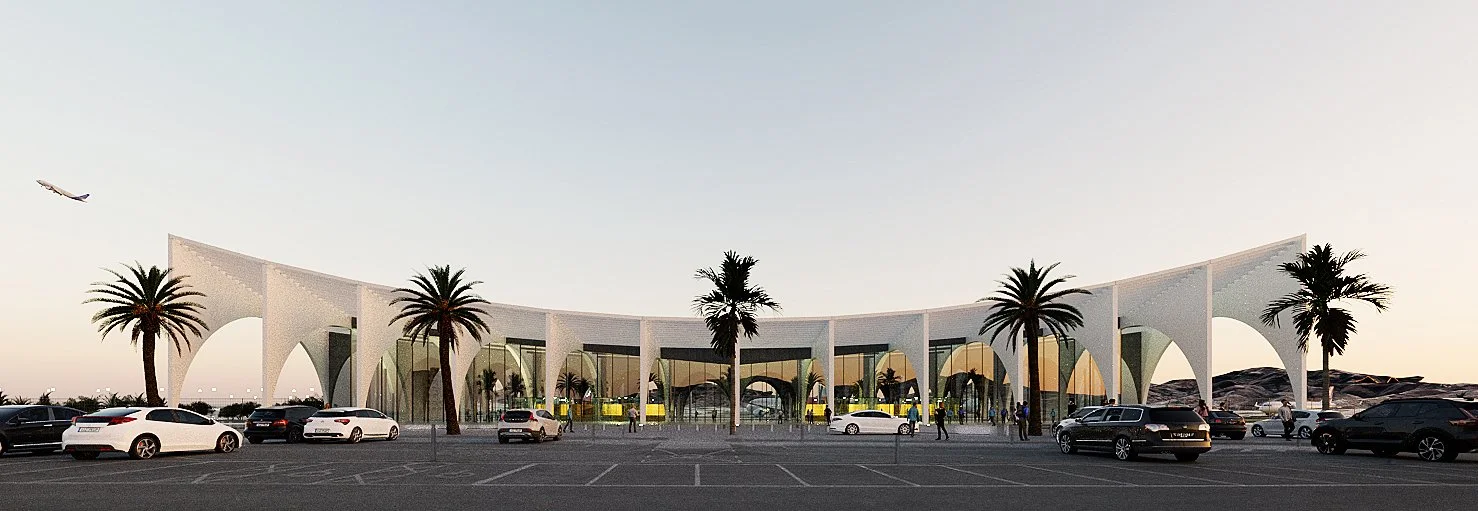ATN
Aeroport Tétouan
Tétouan, MA
FR |
La ville de Tétouan se niche dans une géographie sublime. Elle est enserrée entre deux lignes de collines. Le nouveau terminal s’inscrit dans cette géographie qui fait l’identité de ce territoire. La forme à double pente de la toiture invite le paysage dans le projet. Le bâtiment est un cadre pour percevoir ce paysage. Le terminal s’installe dans une structure, en squelette en béton armé, dont l’expression est puissante mais qui laisse une grande transparence, une porosité qui laisse le paysage traverser le bâtiment. La toiture très largement ajourée au-dessus des volumes principaux de l’entrée et des salles d’embarquement et débarquement donne une qualité de lumière à ces lieux et permet de voir le ciel. Un terminal se voit aussi de haut. La toiture, cette cinquième façade, est une invitation au voyage. Elle se déploie comme une aile qui se pose sur le sol.
La structure du terminal est réticulée dans les deux sens du plan. C’est une série d’arcs porteurs. En utilisant une structure qui se déploie ainsi dans l’espace, le volume intérieur se libère complétement. Les arcs sont une résonnance dans la tradition architecturale marocaine d’une figure de l’accueil, de l’hospitalité, c’est la porte « bab ». Quoi de plus puissante comme métaphore et comme ancrage dans la tradition pour une aérogare ? Mais dans une écriture contemporaine, retenue, presque dépouillée. On n’est pas dans une citation folklorique. On s’inscrit plutôt dans une trajectoire héroïque de l’aventure de l’aviation au Maroc qui de l’aéropostale en passant par les réalisations récentes a laissé des traces architecturales importantes. La structure déborde du volume proprement dit du terminal créant ainsi un porche protégé aussi bien depuis l’entrée que depuis le tarmac. C’est la forme de la structure qui donne l’expression architecturale. Ici pas de double-peau hasardeuse ou de matérialité rapportée. Nous avons voulu un bâtiment puissant, durable et intemporel dans son expression.
ENG |
The city of Tetouan nestles in a sublime geography. It is hemmed in between two lines of hills. The new terminal is part of this geography, which gives the area its identity. The double-sloped roof invites the landscape into the project. The building acts as a frame from which to perceive this landscape. The terminal is housed in a skeletal reinforced concrete structure that is powerful in its expression, but leaves a great deal of transparency, a porosity that lets the landscape pass through the building. The open-work roof over the main volumes of the entrance and the boarding and disembarkation lounges brings a quality of light to these spaces, allowing a view of the sky. A terminal can also be seen from above. The roof, the fifth façade, is an invitation to travel. It unfurls like a wing resting on the ground.
The terminal structure is reticulated in both directions. It is a series of load-bearing arches. By using a structure that unfolds in space in this way, the interior volume is completely freed up. In Moroccan architectural tradition, the arches resonate with a figure of welcome and hospitality: the "bab" door. What could be a more powerful metaphor and traditional anchor for an airport terminal? But in a contemporary, restrained, almost stripped-down style. There's no folkloric quotation here. Rather, it's part of the heroic trajectory of the aviation adventure in Morocco, which, from the aeropostale to recent achievements, has left significant architectural traces. The structure extends beyond the actual volume of the terminal, creating a protected porch both from the entrance and from the tarmac. It is the shape of the structure that provides the architectural expression. No haphazard double-skinning or material additions. We wanted a building that was powerful, durable and timeless in its expression.





